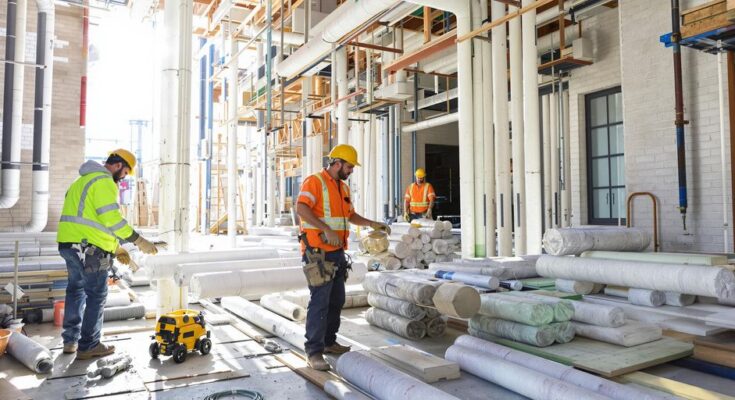Historical Context of Asbestos Usage
Asbestos has a long history in construction due to its fire-resistant and insulating properties. In the mid-20th century, it was a common ingredient in materials like insulation, cement, and roofing. Back then, it was seen as a miracle material, offering durability and heat resistance. However, as its severe health risks became evident, regulations started to limit its use.
Modern Applications in Construction
Today, asbestos use in new construction is rare but not entirely eliminated. While many countries, including the U.S., have banned its use in most applications, it can still be found in certain products like cement sheets, pipeline wraps, and roofing materials. These materials are typically manufactured under strict regulations to minimize exposure risks.
Legal Restrictions on Asbestos Use
In the United States, legal measures have significantly curtailed asbestos use. The Environmental Protection Agency (EPA) oversees its regulation, implementing rules like the Significant New Use Rule (SNUR) to evaluate any new applications of asbestos-containing products. Despite these efforts, construction workers remain at risk of exposure, especially when dealing with older buildings that still contain asbestos.
Health Risks Associated With Asbestos Exposure
Diseases Linked to Asbestos
Exposure to asbestos is directly tied to several severe health conditions, both cancerous and non-cancerous. Mesothelioma, a rare but aggressive cancer, is one of the most well-known illnesses caused by asbestos fibers. It primarily affects the lining of the lungs or abdomen. Another significant concern is asbestos-related lung cancer, which develops in the lung tissue itself and is often fatal. Non-cancerous conditions include asbestosis, a chronic lung disease that leads to scarring and severe breathing difficulties, and pleural effusions, which involve fluid buildup around the lungs. These diseases often take decades to manifest, making early exposure particularly dangerous.
Long-Term Effects of Exposure
The long-term impact of asbestos exposure can be devastating. Once inhaled, asbestos fibers lodge in the body and can remain there indefinitely, causing ongoing irritation and inflammation. Over time, this can lead to chronic conditions, such as pleural thickening, which reduces lung function. The latency period for asbestos-related diseases can span 20 to 50 years, meaning individuals may not realize the damage until it’s too late. This delayed onset complicates diagnosis and treatment, leaving many without timely medical intervention.
Vulnerable Populations
Certain groups face a higher risk of asbestos exposure. Workers in industries like construction, shipbuilding, and automotive repair are particularly vulnerable due to frequent contact with asbestos-containing materials. Additionally, family members of these workers may face secondary exposure through asbestos fibers brought home on clothing. Older adults who lived in homes built before the 1980s are also at risk, as many of these structures still contain asbestos in insulation, flooring, and other materials. Protecting these populations requires targeted education and strict safety protocols.
Regulations Governing Asbestos in the United States
EPA’s Role in Asbestos Regulation
The Environmental Protection Agency (EPA) has been at the forefront of regulating asbestos use in the United States. Their work began in earnest during the 1970s when they issued bans on certain asbestos-containing products. Notably, the 1989 Asbestos Ban and Phase-Out Rule sought to eliminate most uses of asbestos. However, this was largely overturned by the courts in 1991, leaving many products still legal. Today, the EPA continues to evaluate asbestos under the Toxic Substances Control Act (TSCA), ensuring that new uses are carefully reviewed. Recent actions include the 2019 Significant New Use Rule (SNUR), which mandates EPA approval before any new asbestos-containing products can be manufactured or imported.
State-Level Restrictions
While federal regulations provide a baseline, individual states often impose stricter rules. For example, some states ban the use of asbestos outright in certain industries, while others mandate specific safety protocols for handling and removal. These localized efforts aim to address gaps in federal oversight and adapt regulations to regional needs. States like California and New York have been particularly proactive, requiring extensive asbestos abatement measures and public disclosure in real estate transactions.
Significant New Use Rule (SNUR)
The SNUR, enacted in 2019, represents a critical tool in managing asbestos risks. Under this rule, the EPA must evaluate any proposed new uses of asbestos before they can proceed. This ensures that potential health risks are assessed and mitigated before products reach the market. The goal is to prevent a resurgence of asbestos use in industries where safer alternatives exist. This rule underscores the importance of vigilance in regulating hazardous materials and reflects ongoing efforts to minimize exposure.
Asbestos in Older Buildings and Renovations
Common Locations of Asbestos in Older Structures
Many older buildings, particularly those constructed before the 1980s, contain asbestos in various materials. Asbestos was widely used for its heat resistance and durability, making it a common choice in construction. You’ll often find it in:
- Insulation around pipes, boilers, and ducts.
- Roofing shingles and siding materials.
- Vinyl floor tiles, adhesives, and ceiling tiles.
These materials may still exist in homes and commercial buildings, posing a risk if disturbed during maintenance or renovations.
Risks During Renovation Projects
Renovation projects in older buildings can inadvertently release asbestos fibers into the air. When these materials are cut, sanded, or broken, tiny fibers become airborne, and anyone nearby can inhale them. Over time, inhaling asbestos can lead to severe health problems like lung cancer and mesothelioma. To minimize risks:
- Conduct a thorough inspection for asbestos-containing materials before starting work.
- Hire certified professionals to identify and handle any hazardous materials.
- Use protective equipment and follow safety protocols during the project.
Safe Removal Practices
Removing asbestos is not a DIY task—it requires specialized knowledge and equipment. Certified abatement professionals follow strict guidelines to ensure safety. Key steps in the process include:
- Sealing off the work area to prevent fiber spread.
- Using wet methods to suppress dust during removal.
- Properly disposing of asbestos-containing waste in sealed, labeled containers.
For anyone managing asbestos in older buildings, understanding these essential steps is crucial to protect both health and the environment.
Industries Still Using Asbestos Today
Automotive Industry Applications
Asbestos continues to play a role in the automotive industry, despite its well-documented health risks. Vehicle components like brake pads, clutch facings, and transmission plates often contain asbestos due to its heat-resistant properties. These materials need to endure high levels of friction and temperature, making asbestos a practical—though hazardous—choice. It’s worth noting that no amount of asbestos exposure is considered safe. This makes the continued use of asbestos in automotive parts a significant concern for workers involved in manufacturing and repair.
Construction Material Manufacturing
In construction, asbestos is still found in materials such as cement sheets, roofing shingles, and vinyl floor tiles. These products are valued for their durability and resistance to fire and chemicals. However, they pose risks during manufacturing and installation, as well as during renovations or demolitions of older buildings. For example, asbestos-containing pipeline wraps and roofing felt are still legally produced and distributed in the U.S., exposing workers and consumers to potential harm.
Consumer Goods Containing Asbestos
Although less common, asbestos can also be found in certain consumer products. Items such as heat-resistant fabrics and some household appliances may still incorporate asbestos in their design. These products are often imported, as international regulations on asbestos use vary widely. Consumers might unknowingly come into contact with these materials, underscoring the need for greater awareness and stricter controls on imported goods.
Why Asbestos Is Still Found in Certain Products
Economic Factors Behind Continued Use
Despite its well-documented health risks, asbestos is still used in certain products primarily due to its low cost and unique properties. It’s inexpensive to mine and process, which makes it attractive for industries looking to cut costs. For manufacturers, asbestos’ durability and resistance to heat and chemicals make it hard to replace with affordable alternatives. This is especially true in sectors where these properties are critical, such as construction and automotive manufacturing.
Challenges in Finding Alternatives
Finding a substitute for asbestos isn’t as simple as it sounds. Many industries rely on its specific characteristics—like its ability to withstand high temperatures and resist corrosion. While alternatives exist, they often come with drawbacks such as higher costs, reduced effectiveness, or limited availability. For example, some materials that mimic asbestos’ properties may require specialized handling or equipment, which can be a barrier for smaller companies.
Global Perspectives on Asbestos
Globally, the approach to asbestos use varies widely. While many countries have banned or severely restricted it, others continue to use it extensively. In some nations, asbestos is still viewed as an essential material for economic development, particularly in construction and manufacturing. The disparity in regulations and enforcement means that asbestos-containing products can still make their way into international markets, complicating efforts to eliminate its use entirely. This global inconsistency highlights the challenges in creating a unified approach to phasing out asbestos.
The Role of Public Awareness in Reducing Asbestos Risks
Educational Campaigns on Asbestos Dangers
Raising awareness about asbestos starts with educating the public on its risks. Asbestos exposure is directly linked to severe health conditions, such as mesothelioma and lung cancer. Educational efforts often highlight where asbestos might be found, such as in older construction materials or certain consumer products. Schools, workplaces, and community centers can serve as hubs for distributing this vital information. For example, workshops and seminars can teach individuals how to identify potential asbestos-containing materials and the importance of professional removal services.
Community Involvement in Risk Mitigation
Community engagement plays a key role in minimizing asbestos exposure. Local groups can organize events that promote safe practices, like proper handling and disposal of asbestos materials. Additionally, community-driven initiatives can encourage property owners to conduct inspections, especially before renovations. Involving local governments to provide resources, such as subsidized asbestos testing kits or removal services, can make these efforts more effective.
Resources for Identifying Asbestos
Having access to reliable tools and resources is crucial for reducing risks. Homeowners and workers should be aware of testing kits and professional services that can confirm the presence of asbestos. Proper identification is the first step in addressing the problem safely. Regulatory agencies often provide guidelines and checklists to help individuals navigate asbestos-related concerns. Furthermore, public awareness campaigns can guide people toward certified professionals who specialize in safe asbestos removal, ensuring compliance with regulations like the final rule established in April 2019 to limit asbestos use.
Technological Advances in Asbestos Detection and Removal
Innovations in Testing Methods
Modern asbestos testing has come a long way, making detection more accurate and efficient. Transmission Electron Microscopy (TEM) has become the preferred method for identifying asbestos fibers. This technology uses electron beams to analyze materials at a microscopic level, offering unmatched precision in detecting even the smallest traces of asbestos. Other advancements include portable testing devices that allow on-site analysis, reducing the time it takes to identify hazardous materials. These tools are particularly useful in renovation and demolition projects where quick decisions are necessary to ensure safety.
Improved Safety Equipment
The development of advanced safety gear has significantly reduced the risks associated with asbestos removal. High-efficiency particulate air (HEPA) filters are now standard in respirators and vacuum systems, ensuring that asbestos fibers are captured and contained. Additionally, disposable protective suits made from non-permeable materials provide an extra layer of safety for workers handling asbestos. Innovations like these not only protect individuals but also help prevent contamination of surrounding areas.
Future Trends in Asbestos Management
Looking ahead, the integration of artificial intelligence (AI) and robotics in asbestos management is promising. AI-powered systems can analyze data from testing methods like TEM to predict contamination levels more accurately. Meanwhile, robotic systems are being developed to handle asbestos removal in high-risk environments, minimizing human exposure. These technologies could revolutionize the way asbestos is managed, making the process safer and more efficient for everyone involved.
Global Trends in Asbestos Usage and Bans
Countries Leading the Way in Banning Asbestos
Over the years, many nations have taken significant steps to ban asbestos entirely. Countries in the European Union, such as France, Germany, and Italy, have had comprehensive bans in place for decades. These bans extend to the import, production, and use of asbestos-containing products. Australia and Japan have also implemented strict regulations, reflecting their commitment to public health. These countries serve as examples of how policy and enforcement can minimize asbestos-related risks.
International Trade of Asbestos Products
Despite bans in numerous countries, asbestos remains a traded commodity globally. Countries like China and Russia continue to mine and export asbestos, often to nations with less stringent regulations. This ongoing trade complicates efforts to reduce global exposure. For instance, asbestos is still found in products such as cement sheets, gaskets, and adhesives. The disparity in regulations highlights the need for a unified global approach.
Comparative Analysis of Global Policies
When comparing global asbestos policies, stark differences emerge. Developed nations have largely phased out its use, while developing countries often still rely on asbestos for economic reasons. The lack of affordable alternatives is a significant barrier. However, as awareness grows, even countries with limited resources are beginning to explore safer options. The push for international cooperation, along with stricter enforcement of bans, could pave the way for a future where asbestos is no longer a global health threat.
The Future of Asbestos in Construction
Potential for a Complete Ban
The future of asbestos in construction hinges on the possibility of a complete ban. While significant strides have been made—such as the Environmental Protection Agency’s (EPA) recent prohibition of certain asbestos uses—much remains to be done. A total ban would eliminate the loopholes that currently allow asbestos in specific products and industries. However, achieving this requires overcoming resistance from industries still reliant on asbestos and navigating complex international trade dynamics.
Emerging Alternatives to Asbestos
Finding viable substitutes for asbestos has been a priority for researchers and manufacturers. New materials, such as cellulose fibers and thermoplastic composites, are being developed to replicate asbestos’s durability and heat resistance. Some promising alternatives include:
- Polymeric fibers: These are lightweight, heat-resistant, and already used in various industrial applications.
- Amorphous silica fabrics: Known for their thermal insulation properties, these fabrics are being tested as a safer option.
- Geopolymers: These materials are gaining attention for their potential in construction, offering both strength and environmental benefits.
The challenge lies in scaling these solutions to meet global demand while keeping costs competitive.
Impact of Policy Changes on the Industry
Policy reforms play a crucial role in shaping the future of asbestos in construction. Stricter regulations can compel industries to adopt safer practices and invest in alternative materials. For instance, the Ministry of Land Management, Urban Planning, and Construction is pushing for asbestos to be recognized as a significant safety concern in national building codes. Similarly, supporting legislation for stricter asbestos controls could drive innovation and reduce public health risks.
Ultimately, the construction industry’s ability to adapt will determine how quickly we can phase out asbestos entirely. Greater awareness, combined with technological advances, could pave the way for a safer, asbestos-free future.




